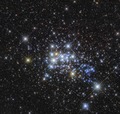Datei:Westerlund 1 - HST - Potw1710a.tif

Originaldatei (2.748 × 2.617 Pixel, Dateigröße: 11,07 MB, MIME-Typ: image/tiff)
![]()
Diese Datei und die Informationen unter dem roten Trennstrich werden aus dem zentralen Medienarchiv Wikimedia Commons eingebunden.
| BeschreibungWesterlund 1 - HST - Potw1710a.tif |
Home to a hypergiant Home to a hypergiant Light travels through space at just under 300 000 kilometres per second! This staggering speed is used to calculate astronomical distances; although often misinterpreted as a unit of time (due to its misleading name), a light-year is actually a unit of astronomical distance, and is defined as the distance that light travels in a year. For reference, this is around nine trillion kilometres… but it’s a little tricky to visualise! With this in mind, 15 000 light-years may sound like a truly huge distance, but compared to the vastness of the cosmos, it’s really quite nearby. In fact, an object sitting 15 000 light-years away would not even be outside our home galaxy, the Milky Way. This is roughly the distance between us and a young super star cluster known as Westerlund 1, home to one of the largest stars ever discovered. Stars are classified according to their spectral type, surface temperature, and luminosity. While studying and classifying the cluster’s constituent stars, astronomers discovered that Westerlund 1 is home to one of the largest stars ever discovered, originally named Westerlund 1-26. It is a red supergiant (although sometimes classified as a hypergiant) with a radius over 1500 times that of our Sun. If Westerlund 1-26 were placed where our Sun is in our Solar System, it would extend out beyond the orbit of Jupiter. Most of Westerlund 1’s stars are thought to have formed in the same burst of activity, meaning that they have similar ages and compositions. The cluster is relatively young in astronomical terms —at around three million years old it is a baby compared to our own Sun, which is some 4.6 billion years old. Credit: ESA/Hubble & NASA Coordinates Position (RA): 16 47 4.05 Position (Dec): -45° 50' 40.46" Field of view: 4.13 x 3.93 arcminutes Orientation: North is 314.4° right of vertical Colours & filters Band Wavelength Telescope Infrared J 1.25 μm Hubble Space Telescope WFC3 Optical Water-CH4 1.39 μm Hubble Space Telescope WFC3 Infrared H 1.6 μm Hubble Space Telescope WFC3. |
|||
| Datum | 6 March 2017, 06:00 (Release) | |||
| Quelle | https://www.spacetelescope.org/images/potw1710a/ | |||
| Urheber | ESA/Hubble and NASA | |||
| Genehmigung (Weiternutzung dieser Datei) |
Diese Datei ist lizenziert unter der Creative-Commons-Lizenz „Namensnennung 4.0 international“. Namensnennung: ESA/Hubble
|
| Bildnotizen InfoField | Diese Datei ist annotiert: Betrachte diese auf Commons. |
W243 (LBV)
W237
W20
W26
W9 (B[e] star)
W75
Kurzbeschreibungen
In dieser Datei abgebildete Objekte
Motiv
Dateiversionen
Klicke auf einen Zeitpunkt, um diese Version zu laden.
| Version vom | Vorschaubild | Maße | Benutzer | Kommentar | |
|---|---|---|---|---|---|
| aktuell | 08:09, 6. Mär. 2017 |  | 2.748 × 2.617 (11,07 MB) | Fabian RRRR | {{Information |Description=Home to a hypergiant Home to a hypergiant Light travels through space at just under 300 000 kilometres per second! This staggering speed is used to calculate astronomical distances; although often misinterpreted as a unit of... |
Dateiverwendung
Die folgende Seite verwendet diese Datei:
Globale Dateiverwendung
Die nachfolgenden anderen Wikis verwenden diese Datei:
- Verwendung auf sv.wikipedia.org
Metadaten
Diese Datei enthält weitere Informationen (beispielsweise Exif-Metadaten), die in der Regel von der Digitalkamera oder dem verwendeten Scanner stammen. Durch nachträgliche Bearbeitung der Originaldatei können einige Details verändert worden sein.
| Breite | 2.748 px |
|---|---|
| Höhe | 2.617 px |
| Bits pro Farbkomponente |
|
| Art der Kompression | LZW |
| Pixelzusammensetzung | RGB |
| Kameraausrichtung | Normal |
| Anzahl Komponenten | 3 |
| Anzahl Zeilen pro Streifen | 31 |
| Horizontale Auflösung | 72 dpi |
| Vertikale Auflösung | 72 dpi |
| Datenausrichtung | Grobformat |
| Software | Adobe Photoshop CC 2015 (Windows) |
| Speicherzeitpunkt | 10:28, 28. Okt. 2016 |
| Farbraum | Nicht kalibriert |

